CoworkingCafe presents a nationwide snapshot of the current state of work/life balance and mental health based on residents’ self-assessments, as well as the more objectively measurable economic, cultural and environmental factors to provide the hard-data background.
Key Takeaways:
- London-area commuter towns — led by St Albans and Sevenoaks — dominate the list of work/life balance and mental health havens. Bracknell and Guildford also land in the top 10.
- London itself ranked 37th overall due to extreme highs and lows with robust incomes and remote work adoption, but also costly housing and limited private green spaces.
- From Manchester’s gravitational field, Stockport and Bury take fourth and 10th places, respectively, with above-average scores across the board.
- Solihull and Warwick lead the way in the Birmingham area with high median incomes and solid remote work culture.
- The Cotswolds also stand out with Cheltenham finishing in third place overall and Gloucester recording the lowest anxiety levels in the nation.
In a competitive global economy where productivity is king and efficiency is queen, the recognition of mental well-being as a cornerstone of sustainable growth is finally taking hold. Taking it another step further, work/life balance is also being widely recognised as one of the most important pillars of mental health and central to job satisfaction and employee retention — to the point where almost two out of three British workers would take a pay cut in exchange for a better work/life balance.
For a comprehensive snapshot of the country’s current mental well-being landscape, we ranked the largest cities based on residents’ self-evaluations on several mental health indicators, in addition to more quantifiable environmental, economic and cultural factors. These included work hours, the adoption rate of remote work, and the accessibility of green spaces, as well as incomes and their local purchasing power as potential triggers or equalizers for anxiety and other mental health problems.
As you’ll discover, most top locations are charming commuter towns with plenty of room to breathe and offering abundant local amenities while maintaining great connectivity to larger hubs.
Check out the full table - See all entries in one place and click on the column headers to sort them by the different metrics.
Jump to the methodology section - Learn more about the calculation processes and the data points.
Naturally, living in a big city like London demands compromises. Accordingly, the capital ranks 37th overall and, while it scores above average in most metrics, the trade-offs are evident: The median income sits high at £41,853, and more than 42% of the workforce operates remotely. But, these benefits come at the cost of steep home prices. Consequently, private green spaces remain a luxury few can afford, despite the abundance of parks.
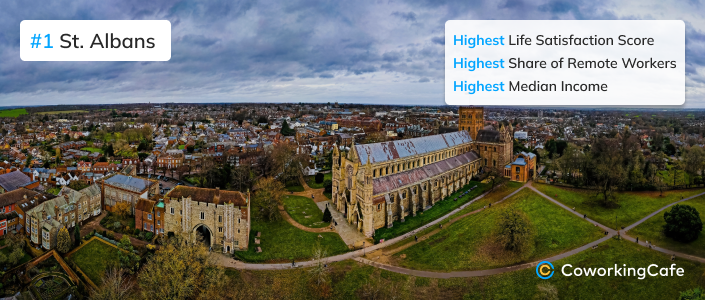
St Albans combines a best-of-both-worlds scenario by marrying the benefits of a serene, rural environment with excellent accessibility to the capital. Although it’s more than 40 kilometres from central London, high-speed trains leave St Albans City station every 15 minutes, and a direct ride to St. Pancras International is less than 20 minutes away. The city also features great schools and a rich historical backdrop, having attracted many young families that aim to settle down without cutting ties with the capital.
By far, St Albans stands out with the highest share of remote workers (53%) and the third-shortest average work week at just under 38 hours to land it in second place overall in the Work category. It also boasts the highest life satisfaction score and ranks in the top five for public green spaces: The average home has about seven parks, public gardens or playing fields within walking distance. However, the property market rivals that of London with comparable affordability metrics despite the higher median income.
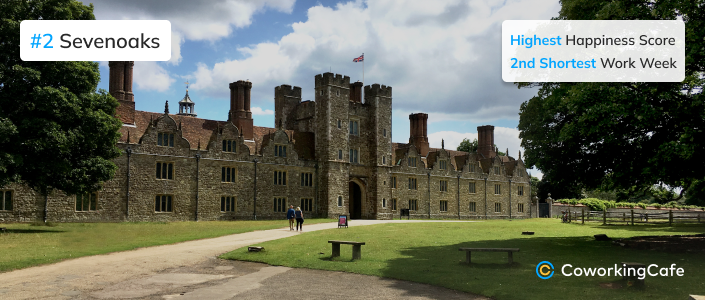
Known for its commuter-friendly location with a half-hour train ride to London Bridge and the newly improved A21 linking toward London and the M25, Sevenoaks also offers various local amenities, like the Sevenoaks Leisure Centre and picturesque trails in Knole Park. What’s more, the town’s health-focused initiatives — such as The Sevenoaks District Health & Wellbeing Partnership — further enhance its well-being credentials.
Notably, Sevenoaks leads in self-reported mental health metrics with the highest happiness level in the nation, the fifth-highest life satisfaction score and fifth-lowest anxiety level. Plus, its average work week is the second-shortest at 37.7 (tied with Guildford and Edinburgh).
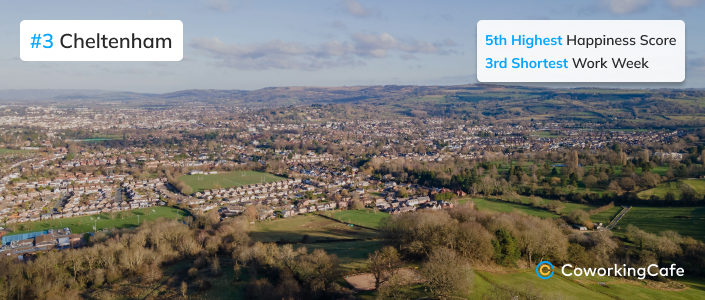
Further west, Cheltenham is renowned for its festival culture and excellent schools, but it’s also living proof that the picturesque Cotswolds attracts more than just tourists and young families. And, with more than 70,000 jobs from cyber-tech through aerospace to engineering, it’s home to several high-profile headquarters, which has reduced unemployment to one of the lowest levels in the country.
Known as the UK’s cyber capital, the progressive workstyle here is reflected in an average work week of less than 38 hours and nearly 37% share of remote workers. Likewise, the effects of a healthy work/life balance are also shown by the fifth-highest reported happiness score and low anxiety level.
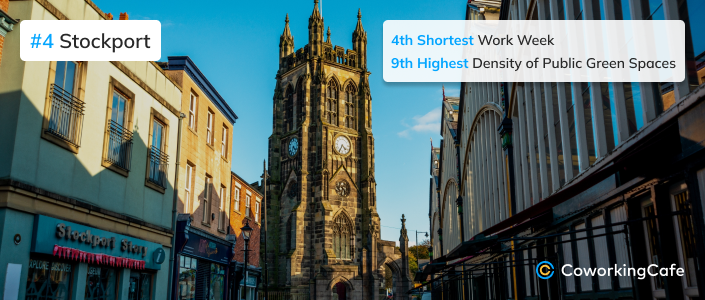
Stockport also combines proximity to a big city with a slower pace of life. Here, the town benefits from a growing cultural scene with developments in the arts and hospitality sectors, and it’s currently going through a £1 billion regeneration project set to bring new housing, transit infrastructure and leisure amenities.
As such, Stockport is a true commuter hub offering family-friendly neighborhoods with less than 15-minute train rides and several traffic arteries straight to Manchester’s city center. It also enjoys the fourth-shortest work week at just 37.9 hours and is within the top 10 locations for access to public parks, gardens and playing fields.
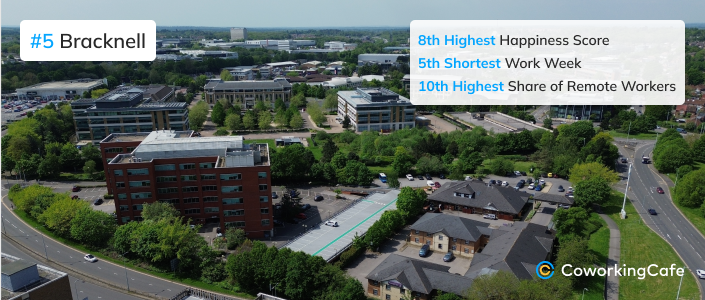
While Bracknell is also relatively close to London, it’s an odd one out in a row of commuter paradises. Granted, that’s not necessarily because transit links are not as efficient as those of St Albans or Sevenoaks, but rather because it offers plenty of well-paid jobs locally with corporations like Dell, Fujitsu, GE, Hitachi and more building its reputation as the UK’s Silicon Valley.
Moreover, Bracknell enjoys the fifth-shortest average work week at 38 hours with nearly 40% of workers operating remotely. It’s also within the top 10 by happiness score.
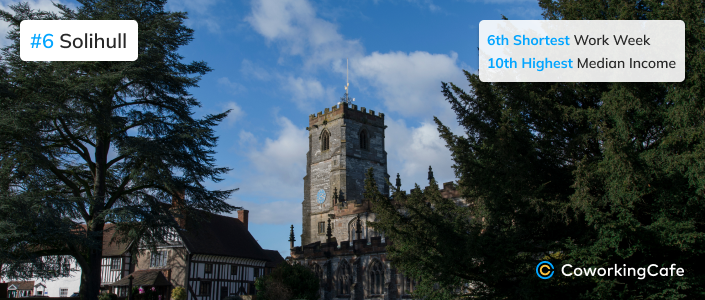
The first Birmingham-area town on the list, Solihull offers a balance between urban connectivity and a serene lifestyle. That makes it an appealing location for families and recognised for its excellent schools and green spaces, but also a strong economic hub with the National Exhibition Centre and Birmingham Airport nearby.
At the same time, Solihull stands out with the sixth-shortest average work week at just more than 38 hours. It also ranks above-average in the financial metrics with a nearly £39,000 median income to offer solid economic prospects.

Guildford excels with the second-shortest average work week (37.7 hours, tied with Sevenoaks and Edinburgh) and ranks third in the work category overall. It also features in the top five for its 44.2% share of remote work and is notable for its £40,000+ median income.
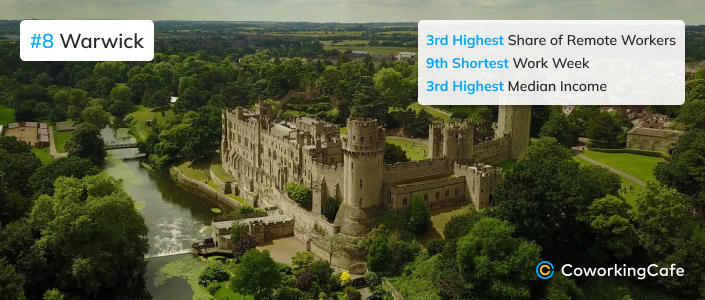
With the third-highest median income of almost £41,250 (close behind London), Warwick ranks highly in the financial and work metrics, particularly for its third-highest share of remote workers at almost 45%. The city also has the ninth-shortest average work week at 38.4 hours, further contributing to a favorable work/life balance.
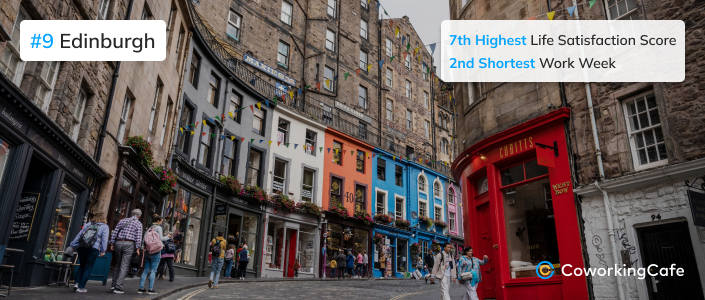
In a tie with Guildford and Sevenoaks, Edinburgh offers the second-shortest average work week and also ranks in the top 10 for life satisfaction. Its balance of work and life metrics makes it a noteworthy example of well-being in a Scottish context.
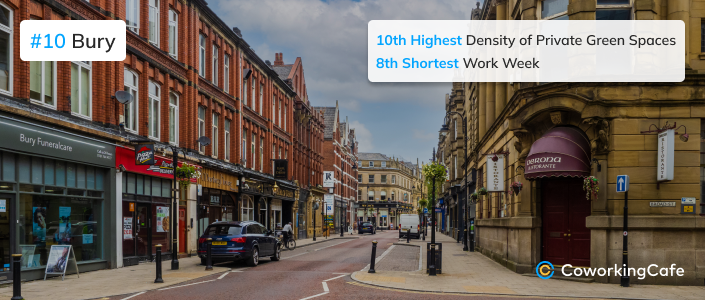
Last, but not least, Bury scores high for its availability of residential green spaces as more than 93% of addresses have a private outdoor space. It also boasts the eighth-shortest average work week at just more than 38 hours. Overall, Bury is well-regarded for its balanced work/life environment and access to green areas.
Beyond the Top 10: Other Notable Cities for Work/Life Balance & Mental Health
While the top 10 cities highlight the best overall state of work/life balance and mental health, several other locations excel in specific areas.
Namely, in terms of mental health, Gloucester stands out with the lowest anxiety levels in the Great Britain, which contributes to its notable second place in the mental health category, despite the median income of less than £31,500 and the 24.2% remote work adoption rate pushing it back to 45th place. Similarly, Telford and Wrekin (#12 overall) also impress with the third-strongest mental health score thanks to high rankings for public green spaces, although the high prevalence of industrial jobs in the area pushed the share of remote workers below 24%. Finally, Stoke-on-Trent (#52) and Rotherham (#62) lead the way when it comes to public and private green spaces, respectively, even though they lag behind in other metrics.
Next, when it comes to work metrics, Cambridge (#25) leads with the shortest average work week coming in at just 37.4 hours and a 45.5% share of remote workers — second only to St Albans in this regard. On the flipside, the city is one of the lowest performers in the mental health category, particularly in terms of overall happiness and life satisfaction. In addition, relatively few addresses have access to a private garden — just 81.5% (comparable to London).
From a financial standpoint, Aberdeen (#38) offers the best overall housing affordability in the country. Although rents take up more than 27% of the local median income, less than four years’ worth of salaries add up to the price of the average home. For comparison, that’s more than double the purchasing power at the national level, as well as more than three times that of London wages.
Then, Stafford (#61) and Preston (#31) round out the affordability podium, both with a rent-to-income ratio of less than 24% and attractive home prices. That said, both also lost important points for their slow adoptions of remote work and low overall mental health indicators. And, although the mere 19.5% remote work adoption rate and the median income of roughly £31,500 pushed Blackburn and Darwen to 32nd place overall, the city boasts the most affordable rents and second-most affordable home prices in the nation with almost 95% of homes coming with at least a patch of greenery.
Methodology
To set up the ranking in this report, CoworkingCafe focused on the largest cities and towns in Great Britain as defined by CIPHR.
The analysis was based on the latest public unitary authority / local authority district-level information from ONS, focusing exclusively on locations with data points for all metrics analysed.
The total scores were calculated using the following data points and weighting:
-
Mental health – 35% of the total index
Personal wellbeing [ONS - Annual Population Survey (2022-2023)]
-
- Life Satisfaction – Average 0-10 score for the question: "Overall, how satisfied are you with your life nowadays? Where 0 is 'not at all satisfied' and 10 is 'completely satisfied." – 20%
- Happiness – Average 0-10 score for the question: "Overall, how happy did you feel yesterday? Where 0 is 'not at all happy' and 10 is 'completely happy."– 20%
- Anxiety – Average 0-10 score for the question: "Overall, how anxious did you feel yesterday? Where 0 is 'not at all anxious' and 10 is 'completely anxious."– 20%
Green spaces [ONS - Ordnance Survey (2020)]
-
- Share of Homes with Private Gardens (Percentage of addresses with private outdoor space) – 20%
- Parks Within Walking Distance (Average number of parks, public gardens or playing fields within 1,000 metres of flats and houses) – 20%
-
-
Work – 35% of the total index
- * Share of Remote Workers (Percentage of residents aged 16+ in employment, working mainly at or from home, out of the total working population) [ONS – Census (2021) (England & Wales); National Records of Scotland – Table UV701 (2022) (Scotland)] – 40%
- Work Hours (Average paid hours worked per week) [ONS – 2023 (Great Britain)] – 60%
-
Affordability – 30% of the total index
- Median Income (Median gross annual personal income, full-time employees) [ONS – 2023 (Great Britain)] – 40%
- Home Price / Median Annual Income (Number of annual median salaries necessary to pay the average house price) [GOV.UK & HM Land Registry – 2023] – 30%
- ** Rent-to-Income Ratio (Average rent / median gross monthly income) [ONS – Private rent and house prices (UK) (2023-2024)] – 30%.
* Scotland data includes full-time students if they provided an address to which they travel to for work or studies.
** London average rent calculated from borough-level data, weighted by population.







